Master AP Calculus AB & BC
Part II. AP CALCULUS AB & BC REVIEW
CHAPTER 9. Applications of Integration
FINDING THE VOLUME OF REGIONS WITH KNOWN CROSS SECTIONS
Until now, all of our rotational solids have had circular cross sections. This section discusses figures whose cross sections are, perhaps, triangles, squares, or semicircles instead. This concept seems incredibly hard until you realize its inherent simplicity. This is just an extension of the Disk Method, and nobody hates the Disk Method! Even many of the most evil people throughout history harbored a fondness for the Disk Method, among them Jesse James, Dracula, and the guy who canceled Star Trek.
In order to find the volume with the Disk Method, you integrated the area of one cross section. Because the cross section was circular, you integrated the formula for the area of a circle (πr2). So, if a new problem has squares as cross sections instead (for example), you will integrate the formula for the area of a square (side2).
There is one other difference in these types of problems. Non circular cross sections are not the result of a rotation, as every other problem has been so far. (You have been rotating about the x- or v-axis or a line such as x = 1.) Instead, these solids grow out of a base on the coordinate plane into the third dim ension. It’s not as hard as it sounds. Consider a circular base on the coordinate axes with equation x2 + y2 = 9. This circle is actually made up of two functions (if you solve for y):
![]() and
and ![]()
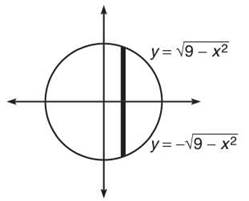
Here’s where your imagination and visualization come in to play. This circle is sort of like how a pedestal is analogous to a statue. A three-dimensional form will sit on top of it and come out of your paper. Imagine that the darkened rectangle in the figure above is the bottom of a square that is sitting on the base. That is not the only square, however. There are squares all along the circle at every possible vertical rectangle. The resulting three-dimensional shape would look something like this:
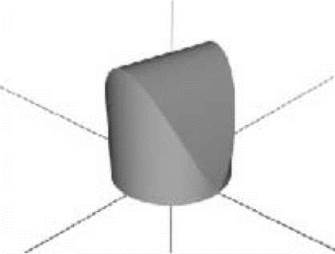
Our job in the next example will be to find the volume of this shape.
Example 6: If a solid has square cross sections perpendicular to the x-axis and has a base bounded by x2 + y2 = 9, what is the volume of that solid?
Solution: We must use vertical rectangles, since they are perpendicular to the v-axis. As stated earlier, all we have to do is to integrate the formula for the area of the figure in question. The formula for the area of a square (with side s) is s2. Therefore, the integral we use to find the volume is
![]()
(The —3 and 3 boundaries are the x-boundaries of the region.) How long is one side of the square? Well, we know that the darkened rectangle in the preceding diagram is the bottom side of the square, and it has length top — bottom = ![]() Therefore, the total volume is
Therefore, the total volume is
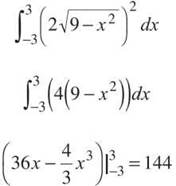
This process is a little bizarre, but it is easy to learn.
3 Steps to Success with Known Cross Sections
1. Draw the graph of the base on the coordinate plane and darken a sample rectangle on it (be careful to draw it as instructed, i.e., perpendicular to the x-axis or y-axis).
2. Determine the length of that rectangle and what relation it has to the shape of the cross section. In the previous example, the rectangle was one of the sides of the squares that formed the cross sections.
3. Integrate the formula for the area of the given cross section, inserting the information you have about the darkened rectangle. Make sure the boundaries match the shape of the rectangle (e.g., y-boundaries if the rectangle is horizontal).
Example 7: Find the volume of a solid that has semicircular cross sections perpendicular to the x-axis whose base is bounded by the graphs of y = x2 and y = √x.
Solution: Begin by drawing the base. Because these cross sections are perpendicular to the x-axis, we will use vertical rectangles and x’s.
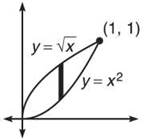
If you are curious, the solid looks like this:
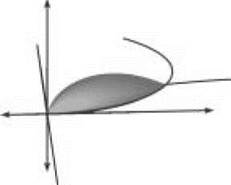
However, it is neither important nor useful to be able to draw this region, so don’t worry if you can’t. The darkened rectangle on the base will have length √x - x2, but what does that length represent? If the cross sections are semicircles, then that must be the diameter, and the semicircles sprout from there. If √x - x2 is the diameter, then 1/2(√x - x2) is the radius of those semicircles. That’s important because the formula for the area of a semicircle is πr2/2. Put all these pieces together to get the total volume:
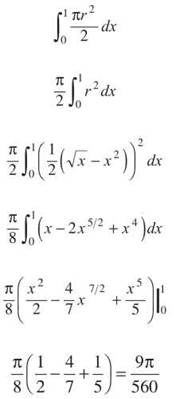
EXERCISE 4
NOTE. The area of an equilateral triangle with side s is ![]() You should memorize that if you don’t know it.
You should memorize that if you don’t know it.
Directions: Solve each of the following problems. Decide which is the best of the choices given and indicate your responses in the book.
YOU MAY USE A GRAPHING CALCULATOR FOR PART (B) OF EACH PROBLEM.
1. Find the volume of the solid whose base is the region bounded by y = —√x and ![]() that has cross sections
that has cross sections
(a) that are rectangles of height 3 perpendicular to the x-axis.
(b) that are equilateral triangles perpendicular to the y-axis.
2. Find the volume of the solid whose base is a circle with radius 5 centered at the origin and that has cross sections
(a) that are isosceles right triangles perpendicular to the x-axis (such that the hypotenuse lies on the base).
(b) that are semiellipses of height 2 perpendicular to the x-axis.
ANSWERS AND EXPLANATIONS
NOTE. The area of an ellipse is πab.
1. (a) First, we need to find the points of intersection.
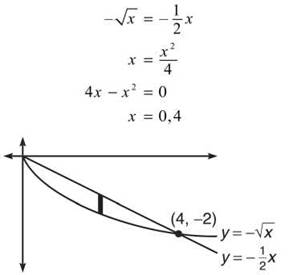
Since the cross sections are rectangles of height 3, the volume will be given by
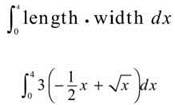
To find the width of the rectangle, you calculate the length of the darkened rectangle, using top — bottom.
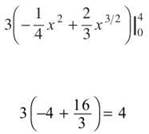
(b) This time, you have to rewrite the equations in terms of y (because the rectangles are perpendicular to the y-axis and, therefore, horizontal). The function y = —√x becomes x = y2; y = —1/2x becomes x = —2y. The length of a side of the triangle is given by right — left = —2y — y2. Therefore, the volume is
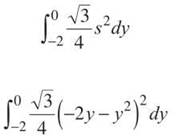
You can use your calculator to find the volume; it is approximately .462.
2. (a) First of all, we need to figure out how to find the area of an isosceles right triangle based on the length of its hypotenuse.

According to the Pythagorean Theorem, 2s2 = h2. Therefore, s = h/√2. The area of the triangle is ![]() If we substitute in for 5, we get
If we substitute in for 5, we get

Now, we can integrate this formula to get the volume of the shape, as soon as we figure out what the length of the hypotenuse is.
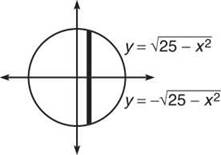
We know that the darkened rectangle represents a hypotenuse, and its length is ![]() Therefore, the volume is
Therefore, the volume is
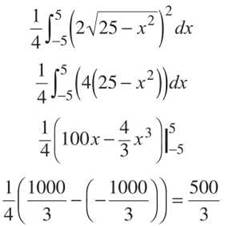
(b) This one is a little tougher to picture. The semiellipse should come out of the base something like this:
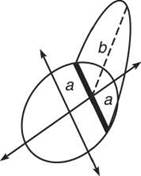
NOTE. You could also have found the volume for the portion of the base from x = 0 to x = 5 and doubled it.
Therefore, the darkened rectangle represents 2a (which means ![]() ), and b = 2 (the height). The area of a semiellipse is πab/2, so the volume of the solid will be
), and b = 2 (the height). The area of a semiellipse is πab/2, so the volume of the solid will be
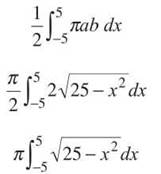
Use your calculator to evaluate this definite integral. The volume will be approximately 123.370.